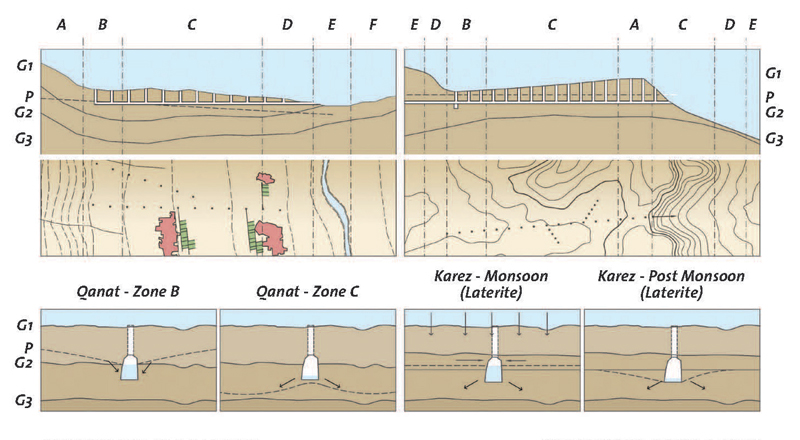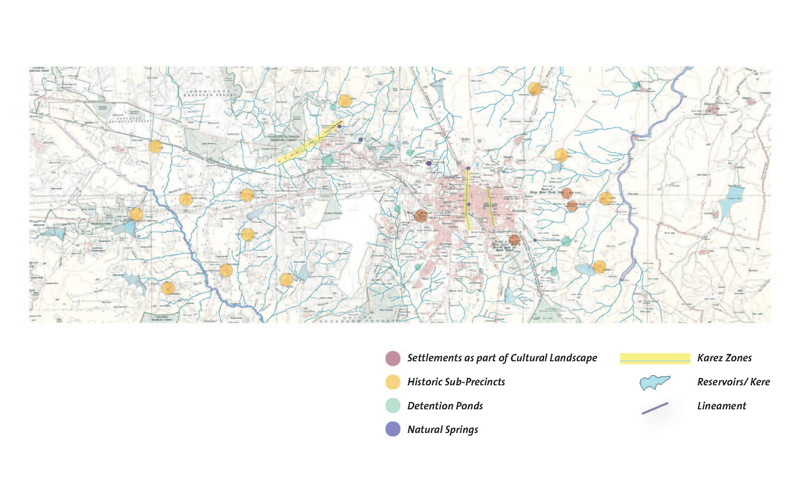Vernacular and Traditional Wisdom
Conservation and Sustainable Use of a Cultural Landscape Feature | FICUS, Bangalore
LA 49 |
|
Naubad Karez at Bidar, Karnataka
Karez- a complex water harvesting system- is today understood to be interlinked with a widely dispersed variety of water footprints including settlements, holding ponds, reservoirs, wells, etc. This, has been observed to influence the landuse in the region of Naubad to a great extent.
While the availability of ground water around Naubad area had become a catalyst for urbanisation, the lack of efficient water management systems, thereof, has led to the contamination of the same. Furthermore, the ignorance and apathy of the people has resulted in the structural deterioration of parts of the underground drains used in the karez system.
|
|
 |
|
The historic town of Bidar situated in the north-eastern tip of Karnataka is known for its architectural, historical and religious significance. Its distinctive topography as an elevated laterite-capped plateau forms the basis of an unique and complex water harvesting system known as a karez. The karez system's roots lie in the well documented qanat systems of Persia. As a self-sustaining system karez were of great agro-economic significance for the
local settlement and provided water for pleasure gardens, orchards and leisure retreats sited in the vicinity. These systems had a well-defined hierarchy of land use from source to mouth.
At the least, three karez systems are known to exist in Bidar. Amongst these, the Jamna Mori Karez and the Shukla Teerth Karez run below the walled city. The Naubad Karez runs to the west of the walled city and is the longest of the three. Its present known extent measures 1.80 kms from the mother well to the karez mouth near Siddheshwara Temple. The plateau of Bidar causes all the karez to straddle two different watersheds, unlike a typical qanat. In this aspect alone, it merits recognition as a typology rather than as a variant. It is speculated that the karez link these watersheds below ground. Topographic evidence and water flows indicate otherwise, suggesting that the alignment principally taps and channelizes groundwater.
Cultural significance of the project
Conservatively dated, the karez's occurrence in Bidar is coeval with the osmosis of Central Asian technology and cultural influences into the Deccan around the early 15th century CE. In the Deccan region, it predates the subterranean water systems found in Bijapur, Burhanpur and Aurangabad - dry regions with dominant black soil and Deccan Trap geology, compared to Bidar's thick lateritic soil. The laterite soil cap and bedding of kaolinite indicating a paleo water level creates an intrinsic difference in hydrogeological behaviour for the karez system at Bidar.
Within Karnataka, it has a slight affinity to the Malenadu (hill regions) of Karnataka known for their surangams - short water tunnels cut into lateritic terrain. The karez forms a unique contrast to early medieval water conservation systems of Northern Karnataka plains, notable for cascading holding ponds and articulated wells. Working models of Central Asian karez point to the highly likely prevalence of similar features and socio-economic organization in Bidar around the 15th century CE.
|
|


|
|

|
|
|
|
|